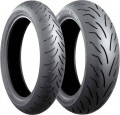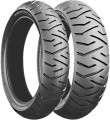The axle on which this tyre is recommended to be mounted.
In the vast majority of modern motorcycles, the
front wheel is steering, and the
rear wheel is driving; in addition, the rear wheel usually bears more weight. Accordingly, the features of the work of both axes will also be different. So, the front tyre has to turn in different directions along the course, and the rear one has to be subjected to increased loads in terms of weight and twisting along the main axis of rotation, in addition, it must “cling” well to the road in order to avoid slipping. In light of all this, putting tyres on a "non-native" axle is highly undesirable: it will work in an emergency mode, and the consequences can be very deplorable. At the same time, there are
universal models suitable for both the front and rear axles (although they can cost more than specialized ones, and at an equal cost, they can be inferior to them in terms of individual characteristics).
The design of the tire depends on the arrangement of the cord threads - a special fiber that gives the rubber base additional strength and rigidity.
-
Radial. In radial models, the cord fibers are located across the tire, parallel to its radius. Such tires are not as prone to heating up as diagonal tires, so they can easily provide a high speed rating (see below). At the same time, radial models are poorly adapted to high weight loads, and their profile is generally flatter and lowered. Therefore, a similar design is found mainly in high-speed tires for sports and road use (see “In the direction”), intended for sport bikes and other relatively light equipment. However, enduro class models can also use this option; but among cross-country ones it is practically not used.
-
Diagonal. In bias-ply tires, the fibers are arranged in the form of a characteristic grid, intersecting each other at an angle of about 40–60°. Such tires heat up more when driving than radial tires, which is why they are poorly suited for high-speed driving. On the other hand, the bias-ply design makes it possible to create high-profile tires with a high load index that can withstand driving well on uneven roads. Therefore, this particular option is used in road tires designed for heavy equipment such as choppers and cruisers, as well as in cross-country models.

